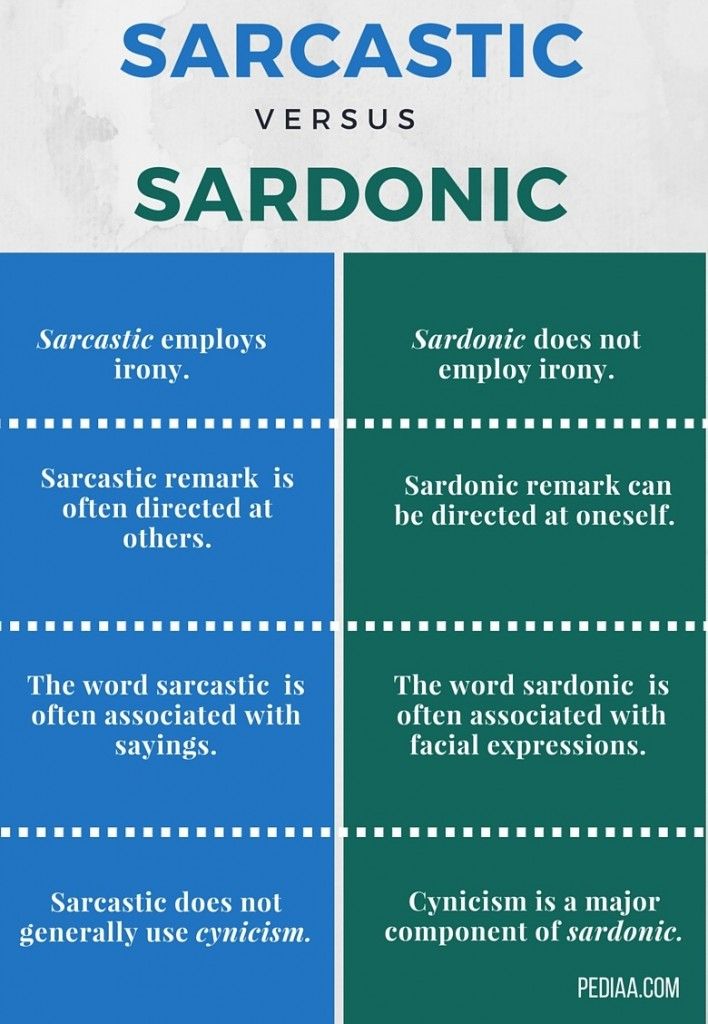讽刺和挖苦经常被交替使用,但两者之间有着微妙的区别。
讽刺是一种反讽形式,用于嘲弄或贬低他人,其尖刻、伶牙俐齿的使用方式让人不屑一顾。 讽刺的使用方式多种多样,可以让人明白道理,也可以逗人发笑。 一些喜剧演员,如安东尼-杰塞尔尼克(Anthony Jeselnik)和诺姆-麦克唐纳(Norm Macdonald),在表演中使用讽刺来逗观众发笑。
没有比讽刺更能表达嘲讽和蔑视的了,言下之意是讽刺的对象理应受到他们言语中表现出的不尊重。
讽刺和挖苦都可以以积极或消极的方式使用。
讽刺是一种用来取笑某人或某事的幽默形式。 它既可以正面使用,也可以反面使用。 例如,当某人粗鲁无礼,而其他人嘲笑他时,这就可以被视为一种讽刺。 如果使用不当,这种幽默形式可能会显得咄咄逼人和刻薄。 它也很平易近人,直奔主题。
我们如何使用讽刺,在什么情况下使用?
我们在日常生活中使用讽刺来表达幽默。 在日常生活中,讽刺是用来开玩笑或取笑别人的。 如果一个朋友告诉你他们刚在海边度过了一天,而你说 "听起来很有趣",这就是讽刺的一个例子。
讽刺就是说一些出乎意料的话,却不期望得到什么结果。
我们如何使用讽刺,在什么情况下使用?
尖酸刻薄是愤世嫉俗的一种表现形式。 它具有讽刺和嘲弄的意味,但并不幽默。 尖酸刻薄通常用于批评或嘲笑某人或某事。 尖酸刻薄的人以一种不屑或愤世嫉俗的方式进行取笑和嘲弄。
问与答
1.讽刺和挖苦有什么区别?
讽刺和挖苦这两个词经常被交替使用,用来形容冷嘲热讽或嘲弄性的评论,但两者之间有微妙的区别。 讽刺更常用来形容意在搞笑或讽刺的评论,而挖苦则更常用来形容意在伤害或不友善的评论。
2. 哪种交流方式更有效?
这个问题没有明确的答案,这取决于语境和您想要表达的意思。
3.哪个更容易得罪人?
一般来说,"讽刺 "和 "诽谤 "更容易让人反感,因为脏话或带有画面感或性暗示的语言比单纯使用贬义词来描述一个人或一个群体更容易让人反感。
See_also: 如何告诉男友你爱他(向他表白的真挚方式) 4.你能在同一个句子中同时使用讽刺和挖苦吗?
是的,您可以在同一句话中同时使用讽刺和挖苦,例如 "我很高兴您对新工作感到满意--讽刺/挖苦",这取决于表达方式和语气。
5.讽刺和挖苦的例子有哪些?
讽刺和挖苦的一些例子是,某人为了嘲笑或侮辱某人而说了一些与真实意思相反的话,或者某人说话的语气干涩、嘲讽或尖酸刻薄。
See_also: 意外触摸是吸引力的象征吗(了解更多信息) 6.讽刺和挖苦有什么区别?
讽刺和挖苦的区别在于,讽刺是为了搞笑或幽默,而挖苦则是为了嘲讽或讥笑。
7.尖酸刻薄的一个例子是什么?
讽刺的一个例子是,如果有人拿敏感或严肃的话题开玩笑,那么他的评论就是为了伤害你。
8.什么是冷幽默?
讽刺诙谐的人是指那些聪明伶俐、快人快语的人,他们经常用讽刺挖苦的方式来取笑他人或场合。
摘要
讽刺是用来嘲笑或取笑某人或某事,通常是为了幽默。 而讽刺则是用来嘲笑或蔑视某人或某事。 虽然讽刺和讽刺都可以用来取笑某人或某事,但讽刺通常更尖刻、更苛刻。

Elmer Harper
Jeremy Cruz, also known by his pen name Elmer Harper, is a passionate writer and body language enthusiast. With a background in psychology, Jeremy has always been fascinated by the unspoken language and subtle cues that govern human interactions. Growing up in a diverse community, where non-verbal communication played a vital role, Jeremy's curiosity about body language started at an early age.After completing his degree in psychology, Jeremy embarked on a journey to understand the intricacies of body language in various social and professional contexts. He attended numerous workshops, seminars, and specialized training programs to master the art of decoding gestures, facial expressions, and postures.Through his blog, Jeremy aims to share his knowledge and insights with a wide audience to help improve their communication skills and enhance their understanding of non-verbal cues. He covers a broad range of topics, including body language in relationships, business, and everyday interactions.Jeremy's writing style is engaging and informative, as he combines his expertise with real-life examples and practical tips. His ability to break down complex concepts into easily understood terms empowers readers to become more effective communicators, both in personal and professional settings.When he's not writing or researching, Jeremy enjoys traveling to different countries toexperience diverse cultures and observe how body language manifests in various societies. He believes that understanding and embracing different non-verbal cues can foster empathy, strengthen connections, and bridge cultural gaps.With his commitment to helping others communicate more effectively and his expertise in body language, Jeremy Cruz, a.k.a. Elmer Harper, continues to influence and inspire readers worldwide on their journey towards mastering the unspoken language of human interaction.



